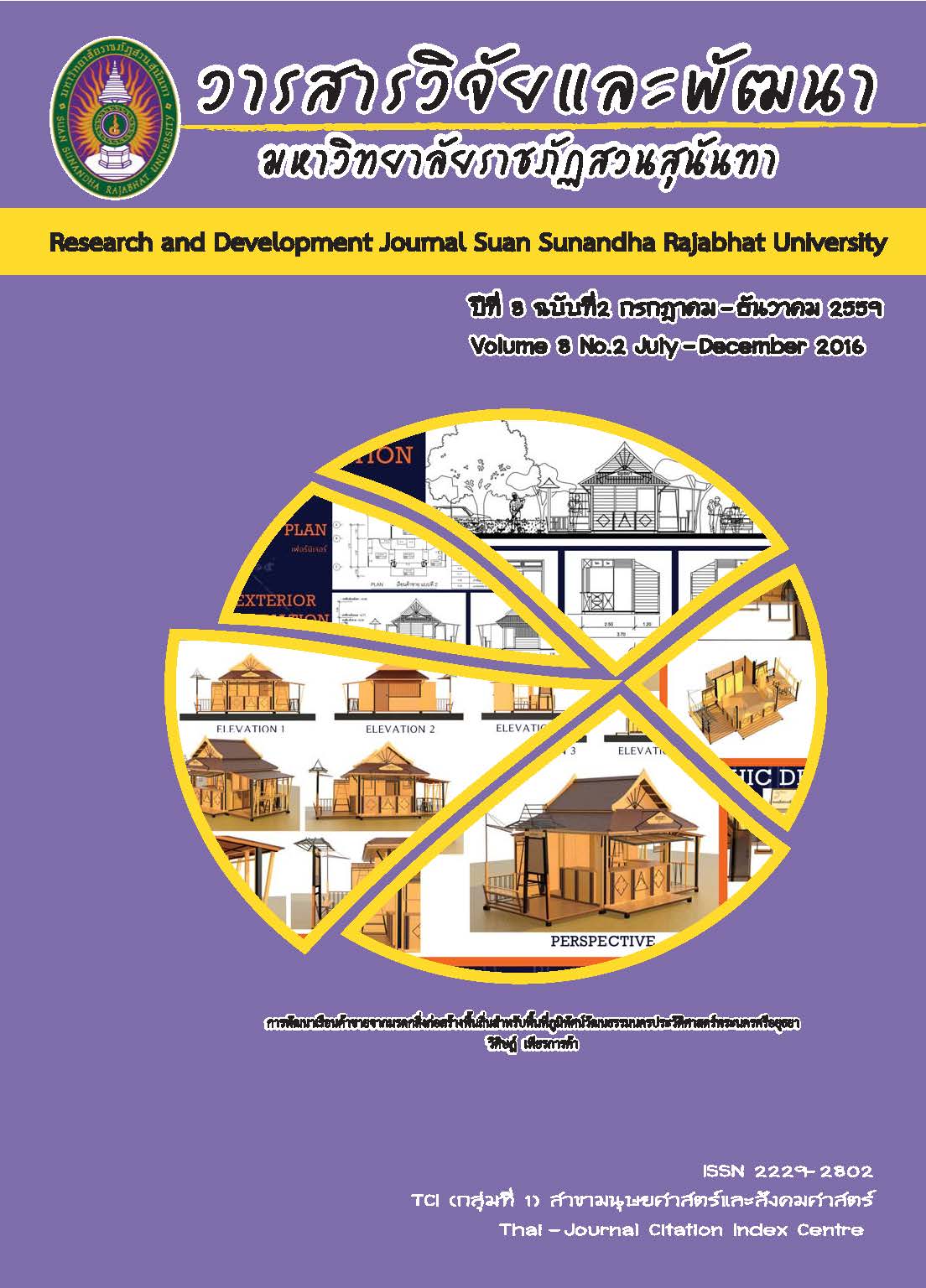การสร้างเครื่องมือเพื่อพัฒนาทักษะการช่วยเหลือตนเอง ส าหรับเด็กสมองพิการ ภายใต้รูปแบบการจัดประสบการณ์การเรียนรู้โดยผู้ปกครองมีส่วนร่วม
DOI:
https://doi.org/10.53848/irdssru.v8i3.214575คำสำคัญ:
สมองพิการ, ทักษะการช่วยเหลือตนเอง, การมีส่วนร่วมของผู้ปกครองบทคัดย่อ
การวิจัยครั้งนี้มีวัตถุประสงค์ คือ 1) เพื่อสร้างเครื่องมือเพื่อพัฒนาทักษะการช่วยเหลือตนเองสeหรับเด็กสมองพิการ และ 2) เพื่อตรวจสอบคุณภาพของเครื่องมือ เครื่องมือที่ใช้ในการวิจัยประกอบด้วย 1) แบบประเมินทักษะการช่วยเหลือตนเอง ส าหรับเด็กสมองพิการ และ 2) แผนการจัดประสบการณ์การเรียนรู้ เพื่อพัฒนาทักษะการช่วยเหลือตนเอง สำหรับเด็กสมองพิการ กลุ่มตัวอย่างที่ใช้ในการวิจัย ได้แก่ 1) เอกสาร และงานวิจัยที่เกี่ยวข้อง และ 2) ผู้เชี่ยวชาญที่มีประสบการณ์การทำงานกับเด็กที่มีความต้องการพิเศษอย่างน้อย 5 ปี โดยการเลือกแบบเจาะจง (Purposive Sampling)
จำนวน 5 คน เครื่องมือนี้พัฒนาขึ้นโดยการบูรณาการจากการศึกษา เอกสาร และงานวิจัยที่เกี่ยวข้องกับเด็กสมองพิการ ทักษะการช่วยเหลือตนเอง และหลักสูตรการจัดการศึกษาส าหรับเด็กที่มีความต้องการพิเศษ จำนวน 4 หลักสูตร การวิจัยนี้ศึกษาคุณภาพด้านความเที่ยงตรงเชิงโครงสร้าง โดยใช้ดัชนีสอดคล้อง IOC และศึกษาด้านความเชื่อมั่น โดยใช้ดัชนีความสอดคล้องของผู้สังเกต (IRR) ด้วยสูตรการ
วิเคราะห์ความแปรปรวนของฮอยท์ (Hoyt’s ANOVA procedure) ผลการวิจัยพบว่า 1) แบบประเมินพัฒนาทักษะการช่วยเหลือตนเอง ส าหรับเด็กสมองพิการ มีค่าดัชนีความสอดคล้อง (IOC) ระหว่าง 0.80ถึง 1.00 และมีค่าความเชื่อมั่นของผู้ประเมิน (IRR) = 1.0 และ 2) แผนการจัดประสบการณ์การเรียนรู้โดยผู้ปกครองมีส่วนร่วม เพื่อพัฒนาทักษะการช่วยเหลือตนเอง ส าหรับเด็กสมองพิการ ประกอบด้วย 3 องค์ประกอบ ได้แก่ 1) ทักษะการรับประทานอาหารและการดื่ม 2) ทักษะการแต่งตัว และ 3) ทักษะการดูแลสุขอนามัยส่วนบุคคล จ านวน 12 แผน มีค่าดัชนีความสอดคล้อง (IOC) ระหว่าง 0.60 ถึง 1.00ดังนั้นเครื่องมือนี้มีความตรงและความเชื่อมั่นเพียงพอที่จะสามารถใช้ในการเป็นเครื่องมือเพื่อทักษะการช่วยเหลือตนเอง ส าหรับเด็กสมองพิการได
เอกสารอ้างอิง
in Basic Motor Abilities, Quality of
Movement and Everyday Activities
Following Intensive, Goal-Directed,
Activity-Focused Physiotherapy in a
Group Setting for Children with
Cerebral Palsy. BMC Pediatr. 10(26)
: 1-11. Retrieved July 1, 2014, from
http://www.biomedcentral.com/14
71-2431/10/26
Bronfenbrenner, U. (2005). Making
Human Beings Human:
Bioecological Perspectives on
Human Development. Thousand
Oaks, CA: Sage Publications.
Cohen, John M; & Uphoff, Norman T.
(1977). Rural Participation:
Concepts and Measures for
Project Design, Implementation
and Evaluation. In Rural
Development Monograph No. 2
.The Rural Development
Committee Center for International
Studies, Cornell University.
Dempsey, I. (2008). A Review of Processes
and Outcomes in Family-Centered
Services for Children With a
Disability. Early Childhood Special
Education. 28 (1): 42-52.
Franzone, E. (2009). Overview of Task
Analysis. Madison, WI: National
Professional Development Center
on Autism Spectrum Disorders,
Waisman Center, University of
Wisconsin.
Gunel, M. K.; et al. (2009, April).
Relationship among the Manual
Ability Classification System (MACS),
the Gross Motor Function
Classification System (GMFCS), and
the Functional Status (WeeFIM) in
Children with Spastic Cerebral
Palsy. Eur J Pediatr. 168(4): 477–
485. Retrieved July 9, 2014, from
http://www.cfd.org.tr
Jennings, D.;& Hanline, Mary F.;& Woods.
Juliann. (2012). Using RoutinesBased Interventions in Early
Childhood Special Education.
Dimensions of Early Childhood.
40(2): 13-22.
Johnson-Martin, Nancy M; & Attermeier,
Susan M; & Hacker. Bonnie J.
(2004). The Carolina Curriculum
for Infants and Toddlers with
Special Needs. 3rd ed. Baltimore:
Paul H. Publishing Co., Inc.
Johnson-Martin, Nancy M; & Attermeier,
Susan M; & Hacker. Bonnie J.. (2006).
The Carolina Curriculum for
Preschoolers with Special Needs.
2
nd ed. Baltimore: Paul H. Publishing
Co., Inc.
Joyce, B.; & Weil, M. (2009). Models of
Teaching. 6
th ed. Boston: Allyn &
Bacon.
Krstic, T.;& Oros. M. (2012, SeptemberOctober). Coping with Stress and
Adaptation in Mothers of Children
with Cerebral Palsy. Med Pregl. 65(9-
10): 373-377.
McWilliam, R. A. (2007). Routines-Based
Early Interventions. Siskin Children's
Institute – The Siskin Center for Child
and Family Research. Retrieved April
27, 2014, from http://www.siskin.org.
Murray, Mary M.; & Mandell, Collen J. (2006,
January). On-the-Job Practices of
Early Childhood Special Education
Providers Trained in Family-Centered
Practices. Journal of Early
Intervention. 28(2): 125–138.
Ohrvall, A. M.; et al. (2010, November). SelfCare and Mobility Skills in Children
with Cerebral Palsy, Related to their
Manual Ability and Gross Motor
Function Classifications.
Developmental Medicine & Child
Neurology. 52(11): 1048–1055.
Pajarya, K. (editors). (1999). Rehabilitation for
Children with Disability. Bangkok:
Green Print.
Pinyoanantapong, B. (2004). Measurement
and Evaluation of Learning
Outcome. (New Assessment).
Bangkok: Faculty of Education:
Srinakharinwirot University.
Pinyoanantapong, B. (2014). Research
Methods and Statistics for
Educational Research (4
thed). n.p.
Prapakarnpanya Training Center for
Children with Intellectual Disability
(2002). Teaching Guide for
Children with Intellectual
Disability Vol 1. Teaching
Techniques and Methods for
Using Development Skills
Inventory for Children. Bangkok:
Printing Hut.
Prapakarnpanya Training Center for
Children with Intellectual Disability.
(2002). Teaching Guide for
Children with Intellectual
Disability Vol 7. Self - Help Skills.
Bangkok: Printing Hut.
Prasongjin, P; et al. (editors). (2010).
The Cerebral Palsy. Bangkok:
Chulalongkorn University.
Rajanukul Institute. (2003). Teaching Life
Skills to Children (4
thed). Bangkok:
Kurusapa Printing.
Saiyot, L ;& Saiyot, A. (2000). Assessment in
the Affective Domain. Bangkok:
Suweeriyasan.
Szidon, K.; & Franzone, E. (2009). Task
Analysis: Steps for
Implementation. National
Professional Development Center
on Autism Spectrum Disorders,
Waisman Center, University of
Wisconsin.
Woods, J.; & Mullis, L. (2001). Application
& Innovations for Routines-Based
Intervention. Presentation in
Temple, TX, August 6 & 7.
ดาวน์โหลด
เผยแพร่แล้ว
รูปแบบการอ้างอิง
ฉบับ
ประเภทบทความ
สัญญาอนุญาต
บทความที่ได้รับการตีพิมพ์เป็นลิขสิทธิ์ของ สถาบันวิจัยและพัฒนา มหาวิทยาลัยราชภัฎสวนสุนันทา
ข้อความที่ปรากฏในบทความแต่ละเรื่องในวารสารวิชาการเล่มนี้เป็นความคิดเห็นส่วนตัวของผู้เขียนแต่ละท่านไม่เกี่ยวข้องกับมหาวิทยาลัยราชภัฎสวนสุนันทา และคณาจารย์ท่านอื่นๆในมหาวิทยาลัยฯ แต่อย่างใด ความรับผิดชอบองค์ประกอบทั้งหมดของบทความแต่ละเรื่องเป็นของผู้เขียนแต่ละท่าน หากมีความผิดพลาดใดๆ ผู้เขียนแต่ละท่านจะรับผิดชอบบทความของตนเองแต่ผู้เดียว





